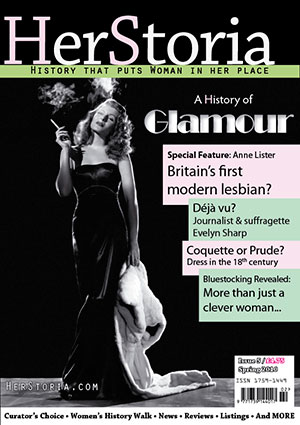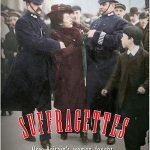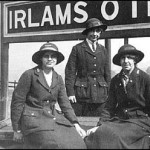A brief history of feminism
By Claire Jones
Many people think of feminism as beginning with the women’s movement of the 1970s, but feminism was around even before bras had been invented - let alone burned.
Women scholars were arguing for a fairer deal for women as early as the 15th century at least (calling for their sisters to receive the education that, unusually for girls, they had been fortunate enough to receive themselves). In the 1400s Italian writer Christine de Pizan decried the lack of appreciation of women in her society and wrote books in which she defended the abilities of the feminine sex and listed great and good women of the past.
In the seventeenth century, Margaret Cavendish, Duchess of Newcastle, a poet, playwright, author and natural philosopher , wrote passionately about women’s lot around the time of the English Civil War. Margaret was angry that women were not treated as rational or capable and were given only ‘petty employments’ unlike the ‘profitable knowledge’ allowed to men. In her opinion, women’s lack of educational opportunity made them……become like worms, that only live in the dull earth of ignorance, winding our selves sometimes out by the help of some refreshing rain of good education, which is seldom given us, for we are kept like birds in cages to hop up and down in our houses. (Philosophical and Physical Opinions, 1655)
Margaret may have fared better if she had been born in the previous century: the dissolution of the monasteries in the 16th century by Henry VIII had removed the religious institutions which had provided some privileged girls with serious educational opportunity and an outlet for their skills and intellect.
But it was not only education that women wanted, they also wanted to be equal citizens with men. Olympe de Gouges, playwright, thought that that dream had come in France in 1789 with the French Revolution. When the new French Republic defined French citizenship as exclusively male in the ‘Declaration of the Rights of Man and of the Citizen’ Olympe de Gouges argued that women should be included too; her argument was unsuccessful and women did not become full citizens under the revolution. Women were not given the vote in France until 1944.

Portrait of Mary Wollstonecraf
Mary Wollstonecraft was also inspired by the French Revolution to call for women’s rights. Her A Vindication of the Rights of Women (1792) not only calls for equal citizenship for women, it also gives a very ‘modern’ analysis of shortcomings in relations between the sexes (including sexual relations and marriage) and argues that lack of education and social conditioning caused women to behave in a silly ‘feminine’ way.
The last half of the nineteenth century in Britain was when a first wave women’s movement really got off the ground. The Langham Place Group was a small network of middle class women who came together in 1859 to campaign on women’s issues, notable members were Barbara Leigh Smith (Barbara Bodichon) and Bessie Rayner Parkes. They formed a committee to lobby for the rights of married women to own their own property (Married Women’s Property Acts), for girls to have grammar schools like boys, and for women to be allowed access to university education. They published the English Woman’s Journal. It was only after a few years that the Journal was confident enough to address the contentious issue of women and the vote, campaigning in support of John Stuart Mill (then MP for Westminster) as he presented the first petition on women’s suffrage to the House in June 1866.
Two sisters, both to become known for their work with women’s issues, were associated with the Langham Place Group: Elizabeth Garrett (to become Dr Elizabeth Garrett Anderson) and Millicent Garrett (later suffrage campaigner Millicent Fawcett). From the late 1860s Fawcett was a leading figure in the suffragist wing of the votes for women campaign which lobbied within the law for change. The later suffragettes of the Women’s Social and Political Union, formed by Emmeline Pankhurst in 1903 after Fawcett had been campaigning for years, adopted their law-breaking strategy in earnest from around 1911.
But winning the vote on a par with men in 1928 was not the complete answer to feminism’s prayer. Discrimination and unfairness still affected women’s lives and having the vote did not ensure women the same opportunity as men. In the twentieth century women were still having to analyse women’s place in society and call for change, leading to a variety of different feminisms (radical, liberal, socialist) and many differences of opinion.

Simone de Beauvoir
Simone de Beauvoir’s The Second Sex (1949) was a landmark in feminist analysis, arguing that woman was perpetually the ‘other’ and that the masculine was always presented as the positive norm. She famously wrote that ‘One was not born a woman, one becomes one’, demonstrating how social conditioning makes a woman womanly – and second class. She urged women to break through this conditioning, become independent and take responsibility for their own lives.
The 1970s saw the rise of the second wave women’s movement, or women’s liberation movement – but these women were also exploring many of the ideas that had exercised their great grandmothers in the 19th century. Reforms they achieved include the 1970 Equal Pay Act, the 1975 Sex Discrimination Act and 1876 Domestic Violence Act. How these acts are operating, and whether they are wholly successful, is still an issue in the 21st century.
But what is feminism? The history of the women’s movements suggest that there is more than one. Does feminism mean calling for equal opportunity and a level playing field for men and women? Or does a ‘sex-blind’ approach lead to women’s special needs, as mothers for example, being ignored? Does feminism mean changing women, or changing men ? The only thing for sure is that this is a debate that will run and run, as it has since the 15th century ………….










Leave a Reply